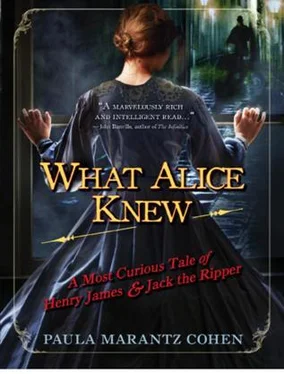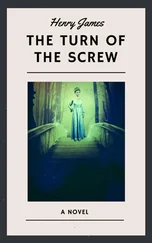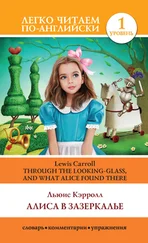“Are you saying that Mary Kelly was killed because of me?” Alice asked. Her face had drained of color, and she was staring fixedly at the picture opposite her bed.
William nodded. “What we find to love or to hate comes to us as a substitute for something else. It wasn’t safe for him to attack you directly, so he found a way to duplicate the scene and put someone else in your place. But his need for substitution has given him away. Sickert must be Jack the Ripper. No one else would know about the bonnet.”
The three siblings were silent, taking in this conclusion.
William rose abruptly, strode across the room, and took the painting from the wall. “I must go immediately to Scotland Yard and present this as evidence,” he said. “We have allowed a murderer to slip through our fingers once; it would be unconscionable if we did so again.”
Before Alice could intervene—for an idea had flashed into her head—he was gone. Henry, however, was still with her, brushing the crumbs from the scone off his lap. She beckoned to him to pull his chair closer to the bed. “There is something I want you to do,” she said, keeping her voice as even as she could. “Now listen carefully.”
Alphonse Legros greeted Henry in his office. There were no classes that day, and he was sitting, looking weary and a little sad, under the large painting by Poussin, that exemplar of the neoclassical style he was constantly exhorting his students to study and imitate.
Unlike his brother, Henry felt sympathy for Legros. It was hard work protecting the artistic establishment against the corrosive forces of the new. He himself sometimes felt prompted to say “no more” when he heard about some of the latest experiments in literary expression: the lady who decided to eschew use of the comma; the young man who insisted on describing fornication. An artist was an individual, but also part of a social system, and thus had a responsibility to stem the tide of vulgarity as far as it was possible to do so. Of course, the new always looked vulgar until one had moved on a bit. Who could tell, but the very things that seemed outrageous now might come to seem routine in time? Knowing this kept Henry from wagging his finger too vigorously, yet he could sympathize with, even envy, Legros for being without such foresight.
Legros proved far more congenial that day than during Henry’s last visit. Perhaps he was feeling lonely and was pleased by the distraction. Whatever it was, he shook his guest’s hand with enthusiasm, offered him a brandy, and bid him take the most comfortable armchair in the room. Best of all, he praised Henry’s work, making special mention of his early novel, Roderick Hudson , whose hero was an artist who had gone to Italy to paint. “I am a strong advocate of the Italian séjour ,” said Legros. “I shall recommend your novel to my students.”
Henry felt himself swell with pleasure. He was as vain of his books as other people were of their children, and he could listen to them praised for hours. But not today. Alice had sent him on an errand, and there was no time to waste. He hurried to get to the point.
“I have come to ask about a statement you made when my brother and I visited you a few days ago. You said that Sickert was not the first difficult student Whistler had hired as an apprentice. You said that he had ‘taken the Slade’s leavings before,’ or something to that effect. What were the leavings you were referring to? Was there someone in particular?”
Legros shifted in his chair. “Yes,” he said carefully, “but it was a shocking case.”
“You can rely on my discretion,” Henry assured him.
“Well then,” said Legros, settling back to embark on the story with a certain prurient relish. “The student’s name was Peter Newsome, a boy of modest circumstances from East London. During his early months, he showed considerable promise, copying the head of a Raphael Madonna extremely well. I recall making a note of it.” He paused.
“Go on,” prompted Henry.
“There was no reason for concern until the life-drawing class during our winter term. It seemed to disturb his… équilibre .” Legros paused again.
“Yes?” prompted Henry.
“Some of our students are always unsettled at first.” Legros cleared his throat. “They have never seen a woman…uncovered. But a woman, a man—in the end, it is the same thing. We teach them to see the body as it has been rendered through the ages, as a matter of proportions and properties. Generally, they become…habituated.”
“But this Newsome did not become…habituated?”
“No,” said Legros.
Henry had begun to feel vaguely alarmed. “And?” he prompted again.
“And one day we found him…in an indecent posture after one of the classes.”
“An indecent posture with the model?”
“ Mais non! ” said Legros, as if this would have been far more acceptable. “An indecent posture…with himself!”
Henry drew a breath. It was as he had somehow expected. “And what was done to the student?”
“His belongings were removed from the premises, and he was asked to leave at once for fear of contamination. It was a great humiliation for the school, though we tried to keep it quiet. It would be assumed that the boy’s career would be over, but Whistler, as I said, took him on.”
“Whistler knew the circumstances?”
“It seems likely that he did. But then, it was Whistler’s way to court scandal and to thumb his nose at established ideas. But he could do nothing with Newsome.”
“Did Newsome…abuse himself again?”
Legros shook his head scornfully. “I have no doubt he continued on the course he had begun, but that was not the issue. Apparently the abuse began to affect the man’s brain and, with it, his art. Whistler wanted no part of him when he found he could no longer draw.”
“He ceased to be a ‘pupil of Whistler’?”
Legros nodded. “It was around this time that he took on Walter Sickert as an apprentice.”
“And what happened to Peter Newsome?”
Legros shrugged. “I cannot say. Perhaps he continues to live off his poor father. Or perhaps he is on the streets or in the workhouse. But as is well-known with regard to such cases, it is only a matter of time before he descends into madness and finds his way to the lunatic asylum.”
William rushed into Abberline’s office with Alice’s portrait under his arm. “We were wrong to release Walter Sickert,” he announced breathlessly, propping the painting against the wall and motioning to it excitedly. “He was painting this portrait of my sister just prior to the death of Mary Jane Kelly. It was clearly her room that inspired the murder. Don’t you see?”
Abberline looked at the picture and shrugged. “I see a woman in bed, and Kelly was in bed. But then, most women do go to bed on occasion,” he noted drily.
William waved his hand. “You’re missing the point! Look at the configuration of the room; look at the bedstead; look at the nightdress. My sister even resembles the victim in age and appearance. And look here.” He gestured to the bonnet that had been painted on the floor to the right of the bed. “My sister said he flung her bonnet on the floor before he painted her. Don’t you recall the photograph we examined together? There’s a bonnet on the floor in precisely the same spot. You noted it and said it was an incongruous sort of thing for the victim to wear.”
Abberline got up and studied the painting closely for a few minutes. “I admit the presence of the bonnet is odd, and the similarity of placement is provocative. But it could well be a coincidence. A night bonnet on the floor, after all…” He broke off and then chewed his lip for a moment. “There were items of women’s apparel in Sickert’s studio, no doubt bonnets among them. Such things are of course commonly in the possession of painters who use female models…” He paused again and then said, “But it does bring to mind another line of thought.” His voice became more excited. “Seeing as this Sickert had in his possession a variety of women’s clothes, it could be that he dressed himself in some of them to make his escape. We concentrated on the idea that he might have left in the cape worn by the woman he came with, which proved to be false, since your friend Miss Cobden said she left at the hour our man saw the caped figure leave. But perhaps Sickert dressed like another sort of woman—like a harlot, for example. The officer on duty that night said he saw women of dubious reputation coming and going throughout the evening. But it never occurred to him—and I can’t say I blame him—to imagine that one of them might be Walter Sickert.”
Читать дальше












